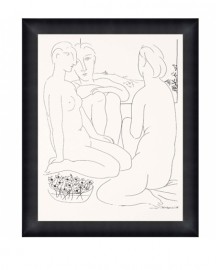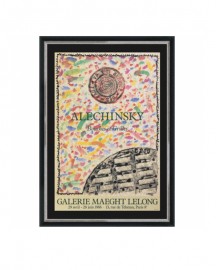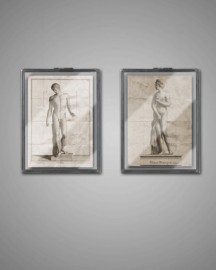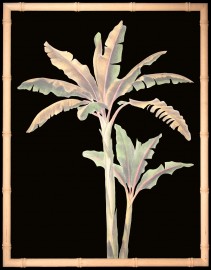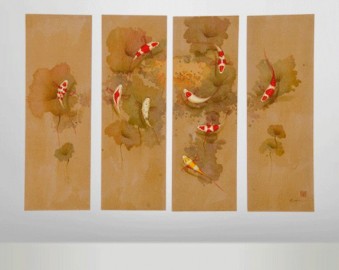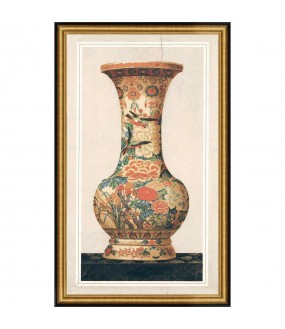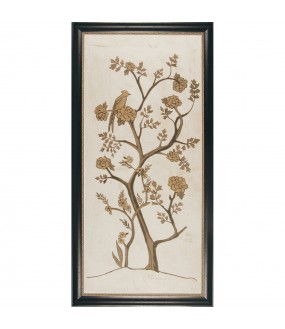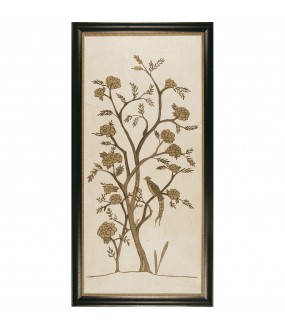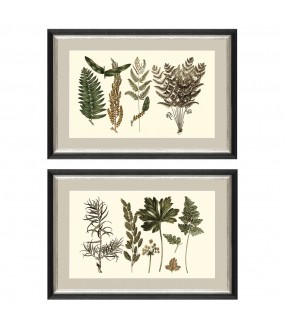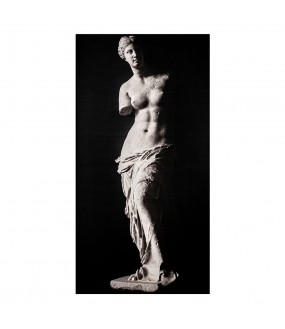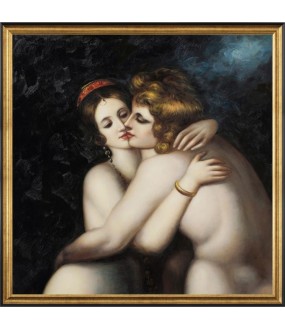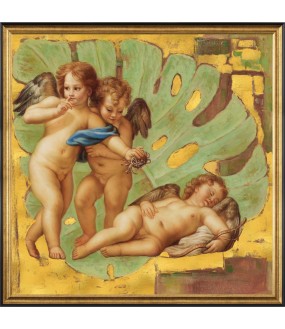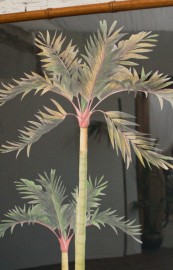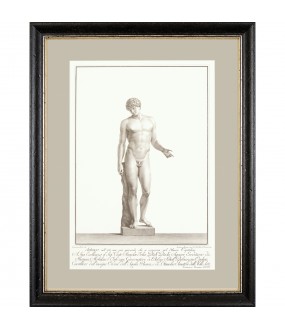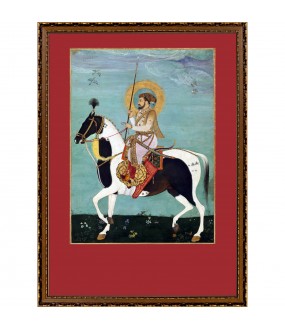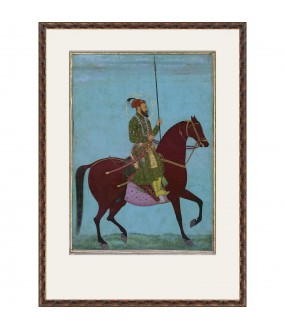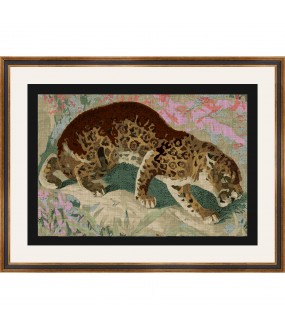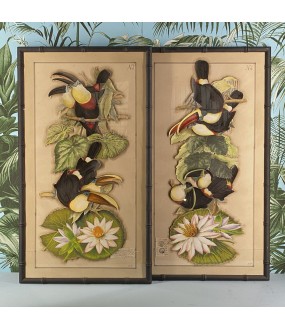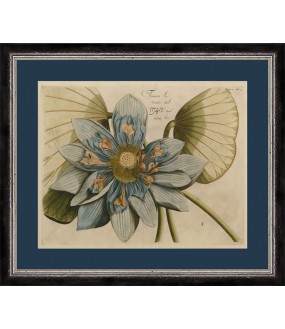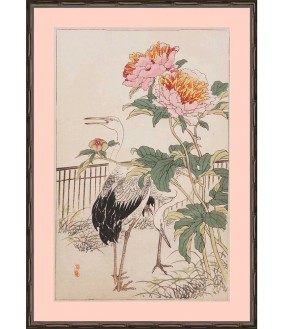PRINTS - BOTANICAL & NATURALIST

-
Matisse, Large Head of Katia - 58xH70cm
€390.00Matisse, Large Head of Katia.
Very beautiful reproductions of engraving made by Matisse.
Each print is surrounded by an elegant black wood frame with silver edging and transparent glass.
Dimensions of each engraving: H70 x 58cm.
Elegance assured.
-
Engraving by Picasso, Three Women
€430.00Large and beautiful reproduction of an engraving made by Picasso.
Each print is surrounded by an elegant black wooden frame and clear glass.
Size of the engraving: H90 x 70cm.
Elegance and refinement guaranteed.
-
Ancient Chinese City Prints, Set of 2
€540.00Reproduction of old engravings of ancient Chinese cities before Mao's communist revolution. Set of 2 very beautiful reproductions of engravings. Each print is surrounded by an elegant black frame with a golden distressed effect and a transparent glass. Dimensions of each engraving: H53 x 65cm. Elegance assured.
-
Print Bouches et Grilles 1986 from Alechinsky
€362.01Superb reproduction of a poster from the Galerie Maeght Lelong from 1986 based on a print by Pierre Alenchisky entitled Bouches et Grilles.
Poster under transparent glass and beautiful blackened wood frame and silver edging.
-
Greek Statuary Wall Display Cases, Set of 2
€160.00Reproductions of charcoal engravings.
Very elegant, these small wall display cases were originally intended to present a collection of drawings. Made of glass, they are hung on the wall as if suspended in the air, with the main advantage of their transparency.
-
Palm Trees Print, Italy
€840.00Large decorative panel made with a collage of palm prints. entirely realized manually in workshop in Italy. This decorative panel is the result of craftsmanship, great expertise and great finesse. This palm engraving, is engraved and printed on old presses of the 1800s in black & white. Then each image is colored by hand with gouache and watercolor
-
Palm Trees Prints, Italy
€840.00Large decorative panel made with a collage of palm prints. entirely realized manually in workshop in Italy. This decorative panel is the result of craftsmanship, great expertise and great finesse. This palm engraving, is engraved and printed on old presses of the 1800s in black & white. Then each image is colored by hand with gouache and watercolor
-
Persian Paintings, Set of 3, H95cm
€900.00Magnificent reproductions of Persian paintings with a height of 95 cm by 65 cm each.
A superb set of 3 paintings.
H 95 x 65 x 6 cm
-
Ancient Chinese Vases Engravings , Set of 2, H70cm
€650.01Set of 2 very beautiful reproductions of engravings of ancient Chinese vases. Each print is surrounded by an elegant distressed wood frame and clear glass.
-
Pair of Fern Leaves Naturalist Engravings...
€520.00Set of 2 very beautiful naturalistic engravings of ferns leaves.
Each engraving is surrounded by an elegant black wooden frame with aged effect silver edging and a transparent window.
Dimensions of each engraving: H50 x 80cm.
Guaranteed elegance.
-
The Galatea canvas 230x110cm
€720.00The Galatea canvas
A canvas straight out of the corridors of time.
Superb black and white print on canvas.
-
Canvas Carved On Wood Gold and Silver 60x60cm
€430.01Decorative panel carved and painted on wood: gold, silver and black frame.
Frame of 60x60 cm, thickness of 4 cm.
-
2 Butterflies Wattercolors Reproductions - 55x70cm
€630.00Watercolor Butterflies Reproductions - Set of 2 Framed Paintings.
Set of 2 very beautiful watercolor reproductions of tropical butterflies. Each print is surrounded by an elegant dark brown frame with an aged effect gold border and clear glass.
Dimensions of each engraving: H70 x 55cm.
Guaranteed elegance.
-
Baroque Love Engraving, 2 sizes available
€250.00Engraving "Love Baroque" available in two sizes 50x50 or 80x80cm.
Put under glass and black wood frame and old-fashioned gilding.
Simply beautiful.
-
Putti Engraving Italian Baroque Style, 2 sizes...
€320.01Italian Renaissance Putti print available in two sizes 50x50 or 80x80cm.
Put under glass and black wood frame and old-fashioned gilding.
Simply magnificent.
-
Palm Trees Prints, Firenze
€840.00 -
Antique Romaine Engravings Piranesi, Set of 4
€760.00Magnificent set of 4 Giovanni Battista Piranesi engravings of reproduced Roman statues framed under glass.
Old black wood frame and gilding.
Absolutely perfect and respectful craftsmanship, rigorous and demanding.
A refined decor for your walls.
Dimensions of one engraving: Height 60cm by 40 cm wide.
-
Engraving of Shah Jahan on Horseback 50x70cm
€360.00Magnificent engraving of Shah Jahan parading on horseback.
Beautiful warm and deep colors, aged carved wood frame.
Dimensions of the glass pane: 50x70cm.
Mirza Shahab-ud-Din Baig Muhammad Khan Khurram (5 January 1592 – 22 January 1666), also known as Shah Jahan I, literally 'King of the World', was the fifth Mongol emperor, reigning from 1628 to 1658. Under his reign, the Mongols reached the height of their architectural achievements and cultural glory.
Third son of Jahangir (r. 1605-1627), Shah Jahan participated in military campaigns against the Rajputs of Mewar and the Lodis of the Deccan. After Jahangir's death in October 1627, Shah Jahan defeated his youngest brother Shahryar Mirza and crowned himself emperor in Agra Fort. In addition to Shahryar, Shah Jahan executed most of his rival claimants to the throne. He commissioned many monuments, including the Red Fort, the Shah Jahan Mosque and the Taj Mahal, where his favorite wife, Mumtaz Mahal, is buried. In foreign affairs, Shah Jahan presided over aggressive campaigns against the Deccan sultanates, conflicts with the Portuguese, and wars with the Safavids. He also put down several local rebellions and faced the devastating Deccan famine of 1630–32.
In September 1657, Shah Jahan fell ill and appointed his eldest son Dara Shikoh as his successor. This appointment led to a succession crisis among his three sons, of which Shah Jahan's third son, Aurangzeb (r. 1658–1707), emerged victorious and became the sixth emperor, executing all of his surviving brothers, including the Crown Prince Dara Shikoh. After Shah Jahan recovered from his illness in July 1658, Aurangzeb imprisoned his father at Agra Fort from July 1658 until his death in January 1666.[6] He was buried next to his wife in the Taj Mahal. His reign is known for putting an end to the liberal policies initiated by Akbar.
During Shah Jahan's era, Islamic revival movements like the Naqshbandi began to shape Mongolian politics.
-
Engraving of Aurangzeb 50x70cm
€360.00Magnificent engraving of Aurangzeb parading on horseback.
Beautiful warm and deep colors, aged carved wood frame.
Dimensions of the glass pane: 50x70cm.
Muhi al-Din Muhammad (c. 1618 – March 3, 1707), commonly known as Aurangzeb lit. 'Ornament of the throne' and by his royal name Alamgir I, lit. 'Conqueror of the world', was the sixth Mughal emperor, reigning from 1658 until his death in 1707.
Under his reign, the Mongol empire reached its peak with a territory covering almost the entire Indian subcontinent.
Widely considered the last effective Mongol ruler, Aurangzeb compiled the Fatawa 'Alamgiri and was among the few monarchs to fully establish Sharia law and Islamic economics throughout the Indian subcontinent.
Aurangzeb belonged to the aristocratic Timurid dynasty, held administrative and military positions under his father Shah Jahan (r. 1628–1658), and was recognized as an accomplished military commander. Aurangzeb was viceroy of Deccan in 1636-1637 and governor of Gujarat in 1645-1647. He jointly administered the provinces of Multan and Sindh in 1648-1652 and continued his expeditions into neighboring Safavid territories. In September 1657, Shah Jahan appointed his eldest and liberal son Dara Shikoh as his successor, a decision repudiated by Aurangzeb, who proclaimed himself emperor in February 1658. In April 1658, Aurangzeb defeated Shikoh's allied army and the kingdom of Marwar at victory. Aurangzeb's decisive victory at the Battle of Samugarh in May 1658 cemented his sovereignty and his suzerainty was recognized throughout the Empire. After Shah Jahan recovered from his illness in July 1658, Aurangzeb declared him incompetent to rule and imprisoned his father in Agra Fort.
-
Set of two Engravings Leopard and Tiger 57x77cm
€820.00Set of two bohemian paintings representing a leopard and a tiger in front of a floral background from Jarman Fagalde.
Engravings under glass with Marie Louise and wooden frame.
Glass dimensions: 57 x 77 cm
Jarman Fagalde is a contemporary artist and graphic designer who creates beautiful abstract, figurative, typography and illustration art perfect for any room in your home.
-
Antique Parrots Engravings, Set of 2
€864.00A set of two beautiful reproductions of engravings of magnificent flamboyantly colored parrots whose species have unfortunately disappeared.
Engravings with powder pink marie-louis and very beautiful black wood ornamentation frame.
Glass size: 50x70cm
-
Toucans Engravings Made by Collages
€2,990.00A pair of magnificent Toucans engravings made from collages of old juxtaposed engravings which are previously hand painted.
A magnificent artisanal work of remarkable finesse executed in Italy according to an ancestral process.
Within each frame an atmosphere is created by a juxtaposition of exquisite hand engravings which are engraved and printed on vintage presses from the 1800s.
Each image is printed in black and white, individually hand colored with gouache and in watercolor then cut out.
Superb and one of a kind.
-
Blue Lotus Engravings, Set of 2
€680.00A set of two beautiful prints of magnificent large blue lotuses.
Engravings with blue marie-louis and very beautiful frame with black wood ornamentation and silver edging.
Glass size: 50x70cm
The lotus is an aquatic plant whose flower is magnificent and which is magnified in these two large engravings in a beautiful blue color. This particular tone of blue has earned it the name of a shade, azure tending to sky blue: caeruleum blue (ceruleum).
The blue lotus is actually a water lily.
Although it bears the name Lotus, the Blue Lotus (in Latin Nymphaea caerulea Savigny) is actually a water lily.
This aquatic plant grows on the edges of lakes and stagnant waters.
Today, it has almost completely disappeared from the Nile region and it is cultivated mainly in Asia (China and Thailand).
The blue lotus belongs to the family Nymphaeaceae (water lily family), group Apocarpiae, subgenus Brachyceras, and forms and subspecies None (cf. Slocum et al. 1996).
Lotuses were the most widely cultivated ritual plants in ancient Egypt. They grew wild and had also been planted in artificial bodies of water (Hugonot 1992).
The blue lotus was considered a sacred plant. The god of immortality and resurrection Nefertum was represented as a young man or a lion whose hair was decorated with a blue lotus flower. He offered the flower to the sun god Ra, to relieve the pain in his old body. The Egyptians especially appreciated their enchanting scent of hyacinth, their symbolism and probably also their intoxicating effects...
Lotus buds and flowers were popular head and hair ornaments. The garlands placed in the tomb of Pharaoh Ramses II (1290-1223 B.C.E.) were almost entirely composed of white and blue lotus flowers (Germer 1988). Many buds, petals and garlands have been found as decoration for mummies or as funerary objects.
In ancient Egypt, the blue lotus was closely linked to the concepts of the afterlife and rebirth. The flower represents enlightenment and the awakened consciousness of the deceased; it is “this lotus flower which shines in the earth” (Book of the Dead, chapter 174, line 30; cf. Dassow 1994).
In the myth of the battle between Horus and Seth, the lotus flower appears as a symbol of the divine all-seeing eye: when Seth found Horus resting under a tree in an oasis, he plucked out both his eyes and buried them in the sand. After which they transformed into lotus flowers.
Lotuses are rustic aquatic plants of absolute beauty, vigorous and imposing and can grow anywhere in France!
-
Engravings by K. Baerei, 19th C. Set of 2
€530.00A set of two beautiful engravings by the 19th century Japanese artist Kono Baerei.
Engravings with black marie-louise and very beautiful frame in aged black wood and gold edging or with a large pink marie-louise and a thin black bamboo imitation frame.
Glass size: 55x80cm
Engravings representing cranes and beautiful peonies under glass.
Bairei became a student of the Maruyama school painter Nakajima Raishō at the age of eight, and then a student of the Shijō school painter Shiokawa Bunrin at the age of twenty-seven. He continued his education in the Nanga school style under Nakanishi Kōseki and Maeda Chōdō. With Gennyo, abbot of Higashi Hongan-ji, he traveled throughout Kyūshū and central Japan, making numerous drawings.
In 1878, Bairei began preparations for an art school, which opened in 1880 as the Kyoto Prefectural School of Painting. He left this school in 1881 and taught his students in his workshop until 1891. In 1893, he became a member of the Arts Committee of the Imperial Household. In 1894, he was commissioned to paint pieces of Higashi Hongan-ji.
Bairei was a prominent figure in Kyoto's artistic circles, where he organized and promoted artistic activities. He played a particularly important role in his educational work. His many students include Takeuchi Seihō, Kikuchi Hōbun, Kawai Gyokudō.
His own work, often characterized by bold brushstrokes, displays traditional charm and sensitivity.
Its flowers, birds (Kachō-ga), and landscapes show a touch of Western realism. Bairei is also known for his spontaneous woodcut sketches.




